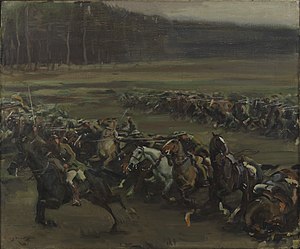
The Second Battle of the Marne was the last major German offensive on the Western Front during the First World War. The attack failed when an Allied counterattack, led by French forces and supported by several hundreds of Renault FT tanks, overwhelmed the Germans on their right flank, inflicting severe casualties. The German defeat marked the start of the relentless Allied advance which culminated in an armistice with Germany about 100 days later.

The Battle of Salamanca took place on 22 July 1812. An Anglo-Portuguese army under the Earl of Wellington defeated Marshal Auguste Marmont's French forces at Arapiles, south of Salamanca, Spain, during the Peninsular War. A Spanish division was also present but took no part in the battle.
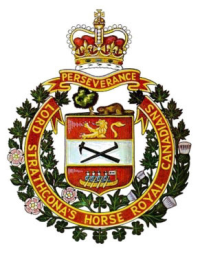
Lord Strathcona's Horse (Royal Canadians) (LdSH[RC]) is a regular armoured regiment of the Canadian Army and is Canada’s only tank regiment. Currently based in Edmonton, Alberta, the regiment is part of 3rd Canadian Division's 1 Canadian Mechanized Brigade Group. Members of the regiment are commonly called Strathconas or Strats as a short form. It was one of the last regiments in the British Empire to be created and raised by a private individual, Donald Alexander Smith, 1st Baron Strathcona and Mount Royal.

Gordon Muriel Flowerdew was an English-born Canadian recipient of the Victoria Cross, the highest and most prestigious award for gallantry in the face of the enemy that can be awarded to British and Commonwealth forces, received for his actions at the Battle of Moreuil Wood.
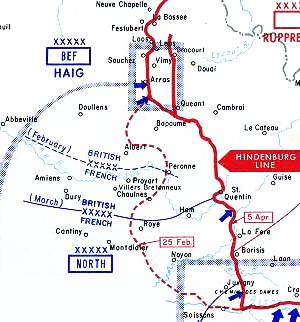
The Hindenburg Line was a German defensive position built during the winter of 1916–1917 on the Western Front in France during the First World War. The line ran from Arras to Laffaux, near Soissons on the Aisne. In 1916, the Battle of Verdun and the Battle of the Somme left the German western armies exhausted and on the Eastern Front, the Brusilov Offensive had inflicted huge losses on the Austro-Hungarian armies and forced the Germans to take over more of the front. The declaration of war by Romania had placed additional strain on the German army and war economy.

The Battle of Amiens, also known as the Third Battle of Picardy, was the opening phase of the Allied offensive which began on 8 August 1918, later known as the Hundred Days Offensive, which ultimately led to the end of World War I. Allied forces advanced over 11 kilometres (7 mi) on the first day, one of the greatest advances of the war, with Gen Henry Rawlinson's British Fourth Army, with nine of its 19 divisions supplied by the fast-moving Australian Corps of Lt General John Monash and Canadian Corps of Lt General Arthur Currie, and Gen Marie Eugène Debeney's French First Army playing a decisive role. The battle is also notable for its effects on both sides' morale and the large number of surrendering German forces. This led Erich Ludendorff to later describe the first day of the battle as "the black day of the German Army". Amiens was one of the first major battles involving armoured warfare.

The Battle of Arras, also known as the Second Battle of Arras, was a British offensive on the Western Front during the First World War. From 9 April to 16 May 1917, British troops attacked German defences near the French city of Arras on the Western Front. The British achieved the longest advance since trench warfare had begun, surpassing the record set by the French Sixth Army on 1 July 1916. The British advance slowed in the next few days and the German defence recovered. The battle became a costly stalemate for both sides and by the end of the battle, the British Third Army and the First Army had suffered about 160,000 casualties and the German 6th Army about 125,000.

The Great Retreat, also known as the retreat from Mons, was the long withdrawal to the River Marne in August and September 1914 by the British Expeditionary Force (BEF) and the French Fifth Army. The Franco-British forces on the Western Front in the First World War had been defeated by the armies of the German Empire at the Battle of Charleroi and the Battle of Mons. A counter-offensive by the Fifth Army, with some assistance from the BEF, at the First Battle of Guise failed to end the German advance and the retreat continued over the Marne. From 5 to 12 September, the First Battle of the Marne ended the Allied retreat and forced the German armies to retire towards the Aisne River and to fight the First Battle of the Aisne (13–28 September). Reciprocal attempts to outflank the opposing armies to the north known as the Race to the Sea followed from (17 September to 17 October).

The 10th Cavalry Brigade was a Polish military unit in World War II. It was the only fully operational Polish motorized infantry unit during the Invasion of Poland, as Warsaw Armoured Motorized Brigade was not completed by September 1, 1939.
The Battle of the Avre, part of the First Battle of Villers-Bretonneux, constituted the final German attack towards Amiens in World War I. It was the point at which the Germans got the closest to Amiens. It was fought between attacking German troops and defending Australian and British troops. The attack was an attempt to take Amiens, where other aspects of Operation Michael had failed. The Avre marked the beginning of the end for Ludendorf's German spring offensive.

The United States campaigns in World War I began after American entry in the war in early April 1917. The American Expeditionary Force (AEF) served on the Western Front, under General John J. Pershing, and engaged in 13 official military campaigns between 1917 and 1918, for which campaign streamers were designated. The streamer uses the colors of the World War I Victory Medal ribbon which had a red center with a rainbow on each side of the center stripe and a purple edge. The double rainbow symbolizes the dawn of a new era and the calm which follows the storm.
The 2nd Indian Cavalry Division was a division of the British Indian Army formed at the outbreak of World War I. It served on the Western Front, being renamed as 5th Cavalry Division on 26 November 1916. In March 1918, the 5th Cavalry Division was broken up. The British and Canadian units remained in France and the Indian elements were sent to Egypt to help constitute 2nd Mounted Division.
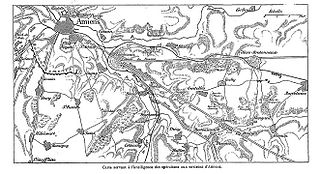
The First Battle of Villers-Bretonneux, took place during Operation Michael, part of the German spring offensive on the Western Front. The offensive began against the British Fifth Army and the Third Army on the Somme and pushed back the British and French reinforcements on the north side of the Somme. The capture of Villers-Bretonneux, close to Amiens, a strategically important road- and rail-junction, would have brought the Germans within artillery-range. In late March, Australian troops were brought south from Belgium as reinforcements to help shore up the line and in early April the Germans launched an attack to capture Villers-Bretonneux. After a determined defence by British and Australian troops, the attackers were close to success until a counter-attack by the 9th Australian Infantry Brigade and by British troops, late in the afternoon of 4 April, restored the line and halted the German advance on Amiens.

The use of horses in World War I marked a transitional period in the evolution of armed conflict. Cavalry units were initially considered essential offensive elements of a military force, but over the course of the war, the vulnerability of horses to modern machine gun, mortar, and artillery fire reduced their utility on the battlefield. This paralleled the development of tanks, which ultimately replaced cavalry in shock tactics. While the perceived value of the horse in war changed dramatically, horses still played a significant role throughout the war.

The Battle of Armentières was fought by German and Franco-British forces in northern France in October 1914, during reciprocal attempts by the armies to envelop the northern flank of their opponent, which has been called the Race to the Sea. Troops of the British Expeditionary Force (BEF) moved north from the Aisne front in early October and then joined in a general advance with French troops further south, pushing German cavalry and Jäger back towards Lille until 19 October. German infantry reinforcements of the 6th Army arrived in the area during October.

Operation Michael was a major German military offensive during World War I that began the German spring offensive on 21 March 1918. It was launched from the Hindenburg Line, in the vicinity of Saint-Quentin, France. Its goal was to break through the Allied (Entente) lines and advance in a north-westerly direction to seize the Channel Ports, which supplied the British Expeditionary Force (BEF), and to drive the BEF into the sea. Two days later General Erich Ludendorff, the chief of the German General Staff, adjusted his plan and pushed for an offensive due west, along the whole of the British front north of the River Somme. This was designed to first separate the French and British Armies before continuing with the original concept of pushing the BEF into the sea. The offensive ended at Villers-Bretonneux, to the east of the Allied communications centre at Amiens, where the Allies managed to halt the German advance; the German Army had suffered many casualties and was unable to maintain supplies to the advancing troops.

In 1917, during the First World War, the armies on the Western Front continued to change their fighting methods, due to the consequences of increased firepower, more automatic weapons, decentralisation of authority and the integration of specialised branches, equipment and techniques into the traditional structures of infantry, artillery and cavalry. Tanks, railways, aircraft, lorries, chemicals, concrete and steel, photography, wireless and advances in medical science increased in importance in all of the armies, as did the influence of the material constraints of geography, climate, demography and economics. The armies encountered growing manpower shortages, caused by the need to replace the losses of 1916 and by the competing demands for labour by civilian industry and agriculture. Dwindling manpower was particularly marked in the French and German armies, which made considerable changes in their methods during the year, simultaneously to pursue military-strategic objectives and to limit casualties.

The Canadian Cavalry Brigade was raised in December 1914, under its first commanding officer Brigadier-General J.E.B. Seely. It was originally composed of two Canadian and one British regiments and an attached artillery battery. The Canadian units were the Royal Canadian Dragoons, Lord Strathcona's Horse and the Royal Canadian Horse Artillery battery. The British regiment was the 2nd King Edward's Horse. 2KEH was replaced by The Fort Garry Horse in February 1916.
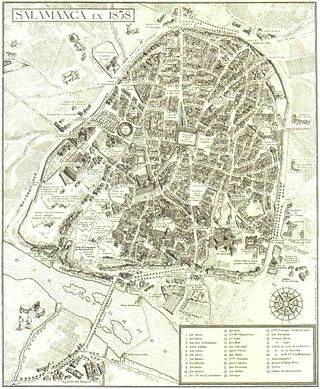
The siege of the Salamanca forts saw an 800-man Imperial French garrison directed by Lieutenant Colonel Duchemin defend three fortified convents in the city of Salamanca against the 48,000-strong Allied army led by Arthur Wellesley, Lord Wellington. During this time, the French commander Marshal Auguste de Marmont led a 40,000-man French army in an unsuccessful attempt to relieve the garrison. An Allied failure to bring sufficient artillery ammunition caused the siege to be prolonged. The garrison repulsed a premature British attempt to storm the fortified convents on 23 June, but finally surrendered four days later after an artillery bombardment breached one fort and set another one on fire. During his maneuvering, Marmont formed the idea that Wellington was only willing to act on the defensive. This mistaken notion would contribute to Marmont's defeat at the Battle of Salamanca a month later.
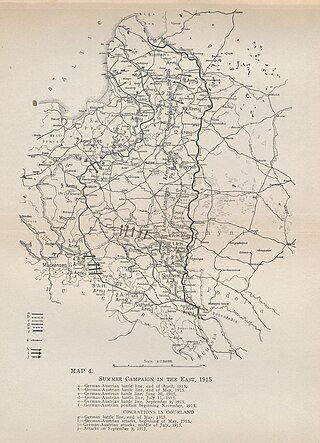
First Riga offensive was a military operation of the German Imperial Army with to divert Russian forces from the direction of the main blow of the German summer offensive on Narew River. The Germans broke through the heavily fortified defenses of the Russian army and defeated the vastly superior enemy forces. However, no decisive success was achieved, and at the beginning of August the Russians launched a counteroffensive.
